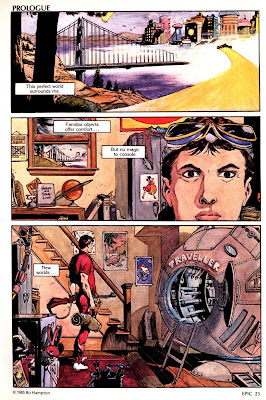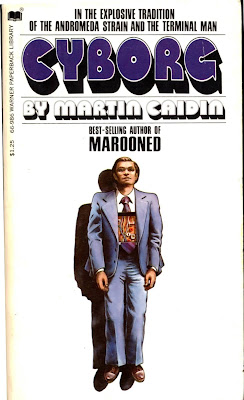DC Comics, September 2020
Thursday, July 29, 2021
Weird Western Tales: Jonah Hex
DC Comics, September 2020
Monday, July 26, 2021
Book Review: If You Believe the Soldiers
Book Review: 'If You Believe the Soldiers' by Alexander Cordell
2 / 5 Stars
'If You Believe the Soldiers' first was published in the UK in 1973; this Coronet paperback version (224 pp.) was published in 1975.
'Alexander Cordell' was the pen name of the UK author George Alexander Graber (1914- 1997). Throughout his career he focused on historical dramas set in Wales, although he also wrote political thrillers that portrayed Communist China in a favorable light, reflecting his sympathies for left-wing causes.
I first encountered 'If You Believe the Soldiers' when Joachim Boaz, at his 'Science Fiction and Other Suspect Ruminations' blog, profiled it in one of his 'recent acquisitions' posts.
I always am partial to fictional portrayals of a Dystopian Britain, and this book seems to fit into that genre.
Or does it.......... ?
The novel is set in the UK in the early 1980s. Its protagonist, Mark Seaton, is a middle-aged bureaucrat who oversees contracts for government construction projects. Seaton divides his time between his office in London and Hatherly, the family estate lying beside the banks of the placid Woking river. In a similar manner, Seaton divides his romantic time between his indifferent wife Moira, and his mistress Hallie Fitzgeralt.
As the novel opens, a right-wing Army officer named Colonel 'Bull' Brander has successfully carried out a coup and converted the UK to fascism. Brander has coerced cooperation from the weak Prime Minster, Paul Whiting-Jones; shut down independent media outlets; and, in a most Providential development, forced the Royal Family into exile in Paris.
The majority of the UK public, drained and apathetic after the strikes and financial chaos of the 1970s, have accepted this change of affairs. However, younger Britons refuse to accept fascist rule and have mounted a violent resistance; the opening pages of 'Soldiers' effectively communicate a near-future London in flames, wracked by destructive battles between the factions of Left and Right.
As a liberal Jew (the original family name is 'Goldstein'), Mark Seaton is hardly partial to the Brander regime, but he is willing to try and work within the system out of a sense of duty to maintain integrity in the government's business dealings.
But as the fascists consolidate power and demand unquestioning fealty from their minions, Seaton's growing defiance becomes a liability to his welfare, and the welfare of those close to him. And crossing the line can come with the most unpleasant consequences.......
For me, 'Soldiers' was a mixed bag. It is clearly not an action adventure novel, detailing the adventures of some Young Comrades who take up arms in a heroic fight against tyranny. Protagonist Seaton is rather dim-witted and passive, sticking to principle because he knows no other way; consequently, throughout the novel he continually is forced to react to one insult after another, never showing much in the way of initiative.
A subplot involving Seaton's adopted daughter of Chinese ancestry veers into Woody and Soon-Yi territory; while this may have been titillating in 1973, no doubt modern readers will find it......... creepy........
Cordell's prose style is uneven; there are lengthy passages, such as those dealing with an emotional resonance occasioned by the landscape of Wales, that deploy an almost poetic language; and then there are those passages where he promotes his left-wing political leanings through Righteous Discourse:
Your middle class did nothing about Heath's Rent Act, the stopping of school milk and meals, the means tests for men on the dole, the hire purchase rackets: the man in the street is on his blood uppers under the mortgage rates. And don't talk to me of demonstrations until you've lived in the slums, where they toss the rats out of the windows before they eat the meal.
*****
Of abstract mind, I wandered, dolefully considering the era
of violence in which I lived; a violence constantly denounced by the unholy liaison
of Church and State, which existed on the fringe of violence, ever ready to
indulge in an orgy of it, should its precepts, or profit, be threatened; using
as its emblem of benevolent dictatorship the public exposure of a man crucified,
bleeding from a dozen wounds before the eyes of the adolescents of a hundred
generations. And in the shadow of such sadism they protested about violence.
*****
......the British soul could never have expected such a decent into the abyss: we, who had never been slaves, were at last enslaved by racism, political adventuring and personal avarice.
'Soldiers' somewhat redeems itself in its closing chapters, which combine dark humor with a string of plot twists. But I finished the book thinking that the book's few moments of suspenseful drama came at the cost of forcing the reader to trudge through much ideological posturing. Accordingly, I give 'If You Believe the Soldiers' a two-star rating.
Friday, July 23, 2021
Epic Illustrated October 1985, issue 32
Issue 32, October 1985
Tuesday, July 20, 2021
Madness: Night Boat to Cairo
'Night Boat to Cairo'
Saturday, July 17, 2021
Book Review: Planet Run
Thursday, July 15, 2021
At the library sale, July 2021
Monday, July 12, 2021
Book Review: Cyborg
'Cyborg' first was published in April 1972 by Arbor House; this paperback edition (318 pp.) was issued by Warner Paperback Library in December 1972 (the cover artist is uncredited).
Both hardbound and paperback copies of 'Cyborg' have Bookjackers demanding steep prices at amazon and eBay. I was able to find a somewhat battered copy of the book at McKay's in Manassas for 65 cents.
'Cyborg' became the basis for the TV series The Six Million Dollar Man, which initially aired on ABC in 1973 as three episodes. Viewership was sufficiently high for the network to order five full seasons over 1974 - 1978. Capitalizing on the success of the TV show, Caidin wrote two more Steve Austin novels, 'High Crystal' (1974) and 'Cyborg IV' (1975).
A gallery of the various editions of Caidin's 'Cyborg' novels, including some impressive paintings by UK artist Richard Clifton-Dey, is available at the Dead Man's Brain blog.
'Cyborg' is set in the mid-70s and as it opens, 32 year-old Steve Austin, NASA's youngest astronaut and one of its best test pilots, is conducting a trial flight of the M2-F2 lifting body aircraft. Coming in for a landing, the aircraft goes out of control and crashes on the runway (footage of the actual crash of the M2-F2 on May 10, 1967, involving pilot Bruce Peterson, was used in the opening sequence of The Six Million Dollar Man).
Austin survives the crash, albeit with severe injuries. But physicians Rudy Wells and Michael Killian have a plan, one that will be funded - to the tune of 6 million dollars (a large sum by 1970s standards) - by Oscar Goldman, director of the federal government's clandestine Office of Special Operations (OSO).
Steve Austin will be the world's first Bionic Man........a cyborg whose body is a combination of the organic and inorganic. Rebuilding Austin will require the most advanced technologies yet known to man, and the path to recovery and functionality will be a long and arduous one. But if any one man can do it, it will be Steve Austin.
However, as Austin is to discover, when the OSO invests 6 million dollars in your rehabilitation, it's never done out of kindness. Oscar Goldman wants a return on his investment.........a return that involves a dangerous mission to covertly retrieve foreign technology. And what would be a suicide mission for an ordinary spy, may be entirely feasible for a bionic man............
The opening chapters of 'Cyborg' are engaging, as Caidin relates - in crisp prose - the execution of the ill-fated flight, the disastrous accident, and the desperate effort to salvage what's left of astronaut Austin.
The middle chapters see the narrative lose momentum, as Caidin belabors the psychological and emotional traumas that accompany Austin's efforts to adapt to his new existence as a bionic man. Needless to say, melodrama was not author Caidin's strong suit as a writer: the too-plentiful scenes in which Austin acts out in anger against his medical team, and wallows in self-pity, foster a contrived melodrama and (unintentionally, I'm guessing) permit the reader to readily conclude that Austin is a Prick.
Steve Austin doesn't make the transition from experimental subject to a Nick Fury Agent of S.H.I.E.L.D. 'superspy' until page 201, well into the novel. Things pick up plot-wise at this point, as Austin undertakes dangerous missions against the infrastructure of the Soviet Bloc, and the final third of the book is rewarding for those who like well-composed action sequences, particularly those featuring aeronautical derring-do, a subject with which Caidin was well acquainted.
The closing chapters then shift the emphasis to a survival scenario, one of the best such sequences I've ever read.
It's worth noting that in 'Cyborg' Steve Austin has no scruples about using his superhuman powers to kill Commies, rape-hungry Arabs, and other 1970s 'undesirables'. These episodes of violence give the novel a harder edge that The Six Million Dollar Man (which aired in Prime Time) was not permitted.
[ I should alert potential readers under 30 that Caidin's depiction of women in the pages of 'Cyborg' is very un-Woke; however, those over 30 likely will be entertained by the chauvanistic sensibility that permeates the novel. ]
The verdict ? While I can't recommend that you spend considerable money to acquire a copy of 'Cyborg', if you can find it for a reasonable price, it's worth picking up. Overall, its melding of sci-fi and action works well and retains that distinctive Old School, Macho-Man flavor that nowadays is fast fading into distant memory.
Friday, July 9, 2021
The Fabulous Furry Freak Brothers and the Mysterious Visitor
by Gilbert Shelton and Dave Sheridan
from Thoroughly Ripped with the Fabulous Furry Freak Brothers (Rip Off Press, 1978)
Tuesday, July 6, 2021
Junk food from Ollie's
Ollie's Bargain Outlet is a chain of discount stores that started in central Pennsylvania in the 1980s, and now has stores in 25 states. They usually lease their stores in formerly prosperous shopping centers........what may have been a thriving PetCo, or Kmart, or Joann Fabrics in 2003, is now an Ollie's.
Some of the parking lots where Ollie's are located require concentration and care to negotiate......I recently was at the Frederick, Maryland store (second from top, above) and while inside, a severe thunderstorm swept into the area. The rain was pounding on the store roof so hard I couldn't hear the music playing on the speaker system. When I had waited out the worst of the rain by standing under the storefront, I discovered that the parking lot had flooded, and I had to wade through ankle-deep water to my car.........
I periodically visit Ollie's for sundries. The chain advertises itself as 'Good stuff - cheap !' and that's true. Ollie's buys truckloads of surplus inventory and sells it at discounted prices, exclusively in its brick-and-mortar stores (the chain has no online sales portal). According to a 2019 article in Forbes, Ollie's is thriving at a time when many brick-and-mortar stores are not doing well.
According to Forbes, Ollies customers '.....tend to be lower-middle class or poorer.......' Whether I qualify for this designation is open to contemplation, but I do find Ollie's a source for cheap junk food. Some brands that aren't available in other stores can be found at Ollie's; for example, while Mallow Cups from Boyer were plentiful in my youth during the 70s, I haven't seen them anywhere in the past 20 (30 ?!) years, but I found big packs of them at Ollies.
Some of the items available at Ollie's represent flavors that didn't survive the brutal competition on the shelves of major grocery stores. In that regard, perhaps it's for the best that 'S'mores' flavored snack balls, 'Orange Cream Pop' snack balls, and 'Dippin' Dots' snack balls have been expunged from the retail environment.And let's be fair. If a bag of chips is priced at $1.89, or a box of 16 exotically flavored Pop Tarts is only $2.59, you're not spending a whole lot of money to investigate, are you ?
Saturday, July 3, 2021
Book Review: Thieves' World
Thursday, July 1, 2021
My Sweet Summer Suite
by Barry White and the Love Unlimited Orchestra























































.jpg)
.jpg)
















